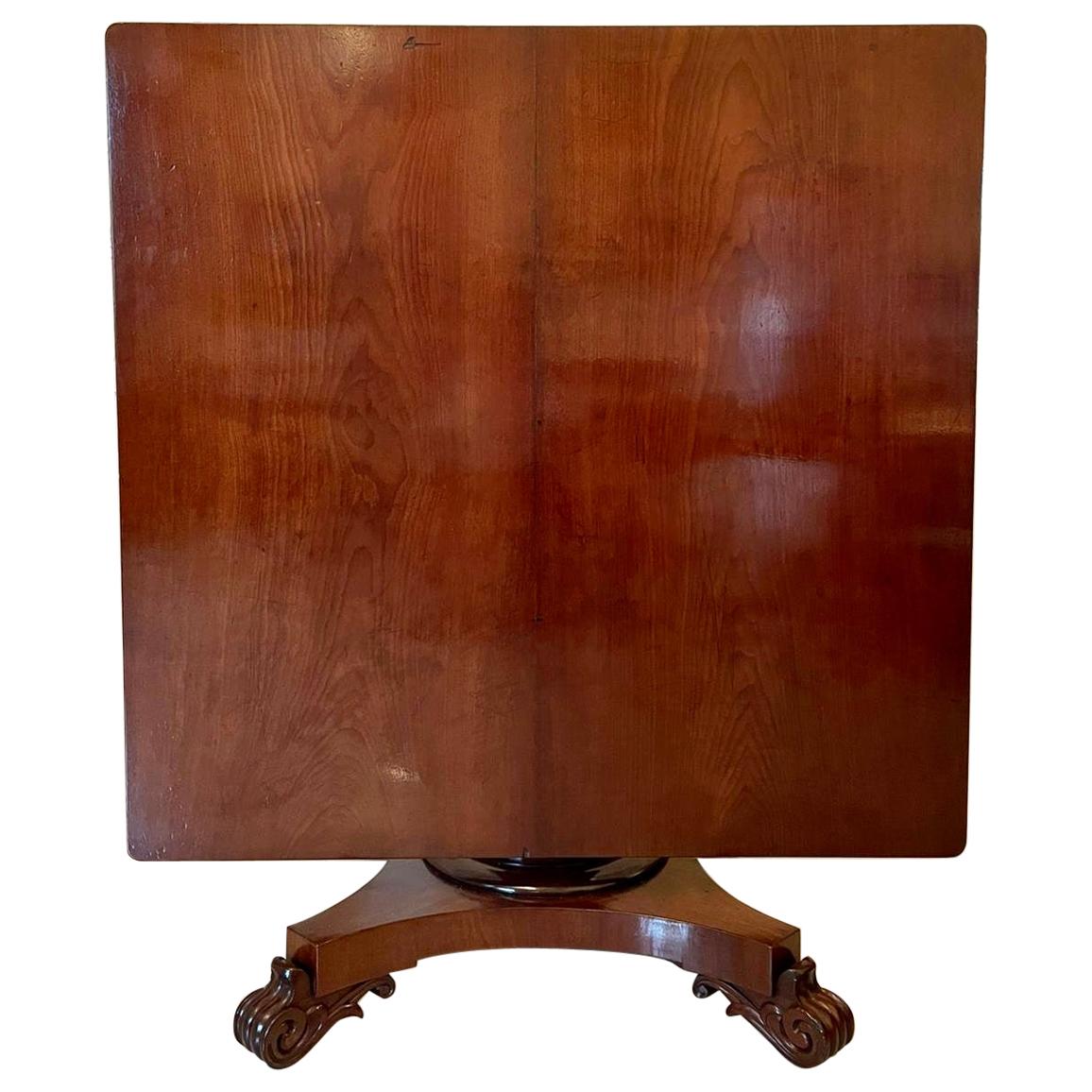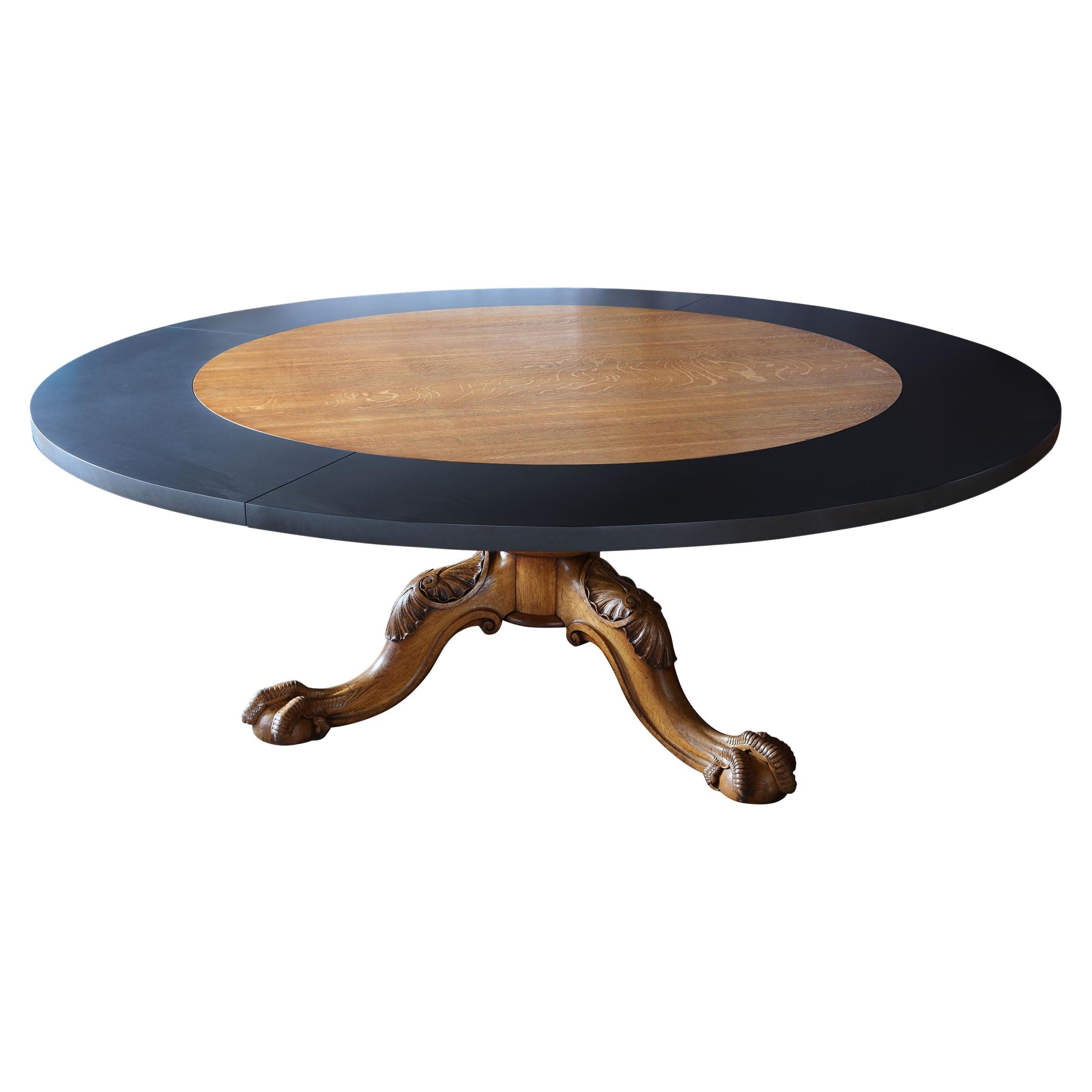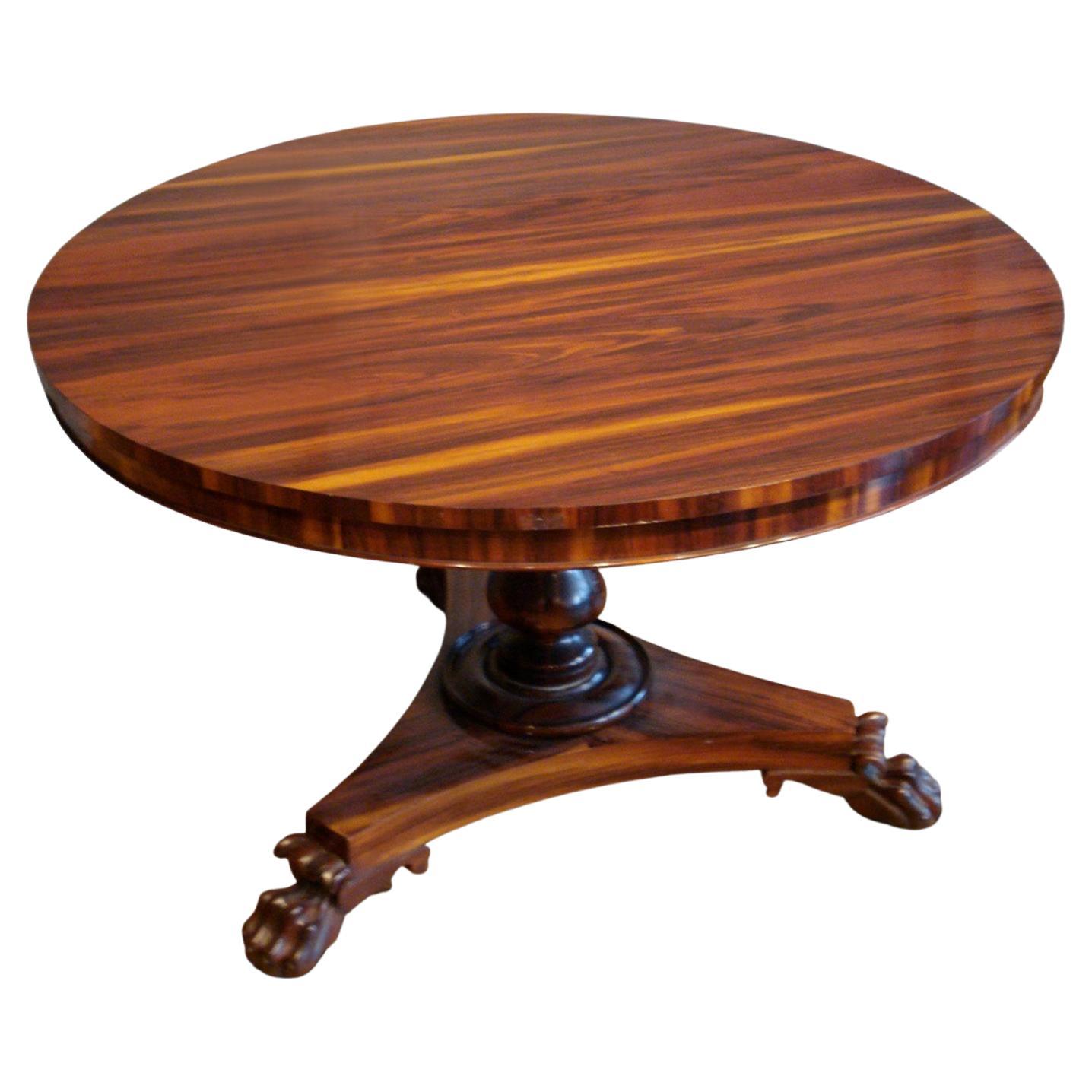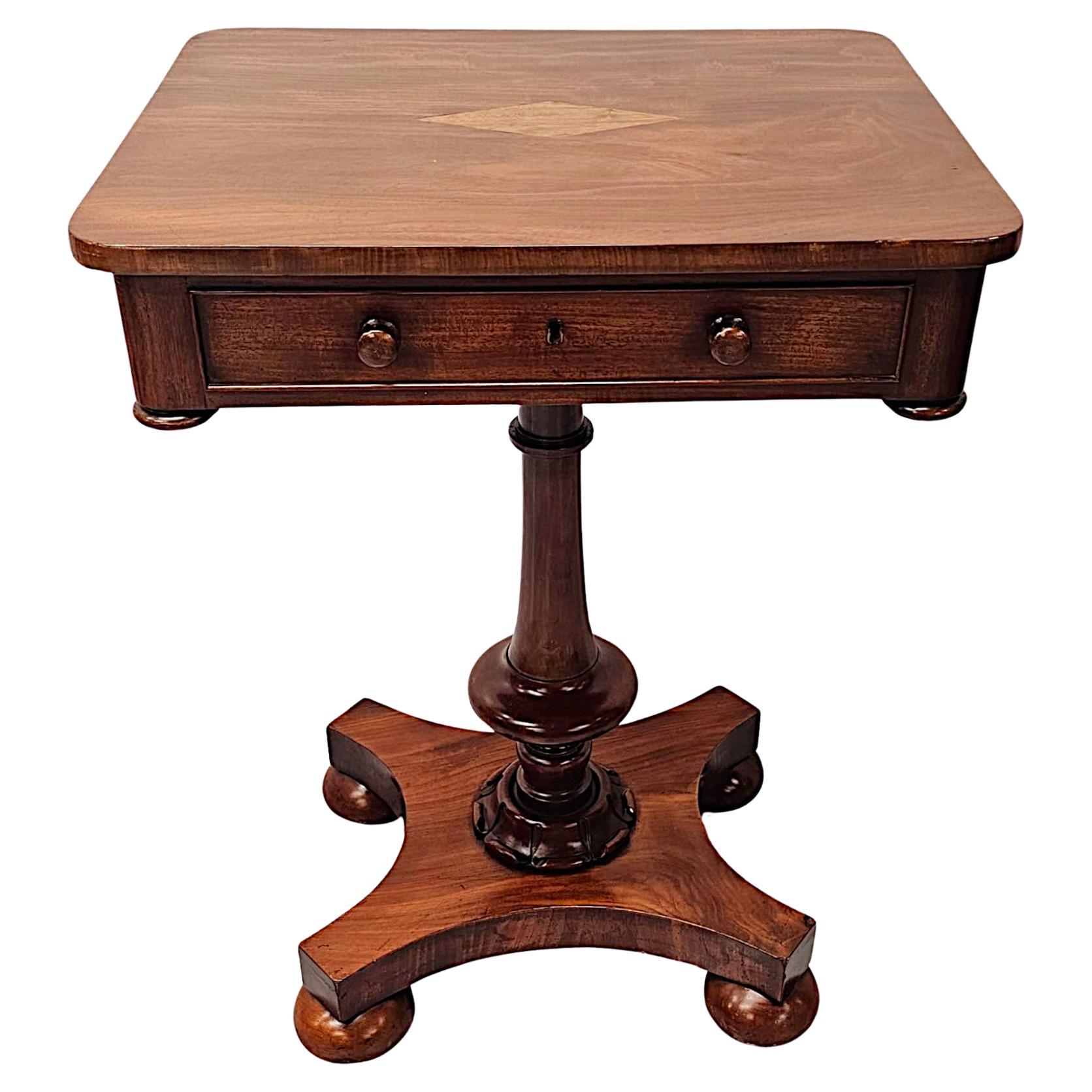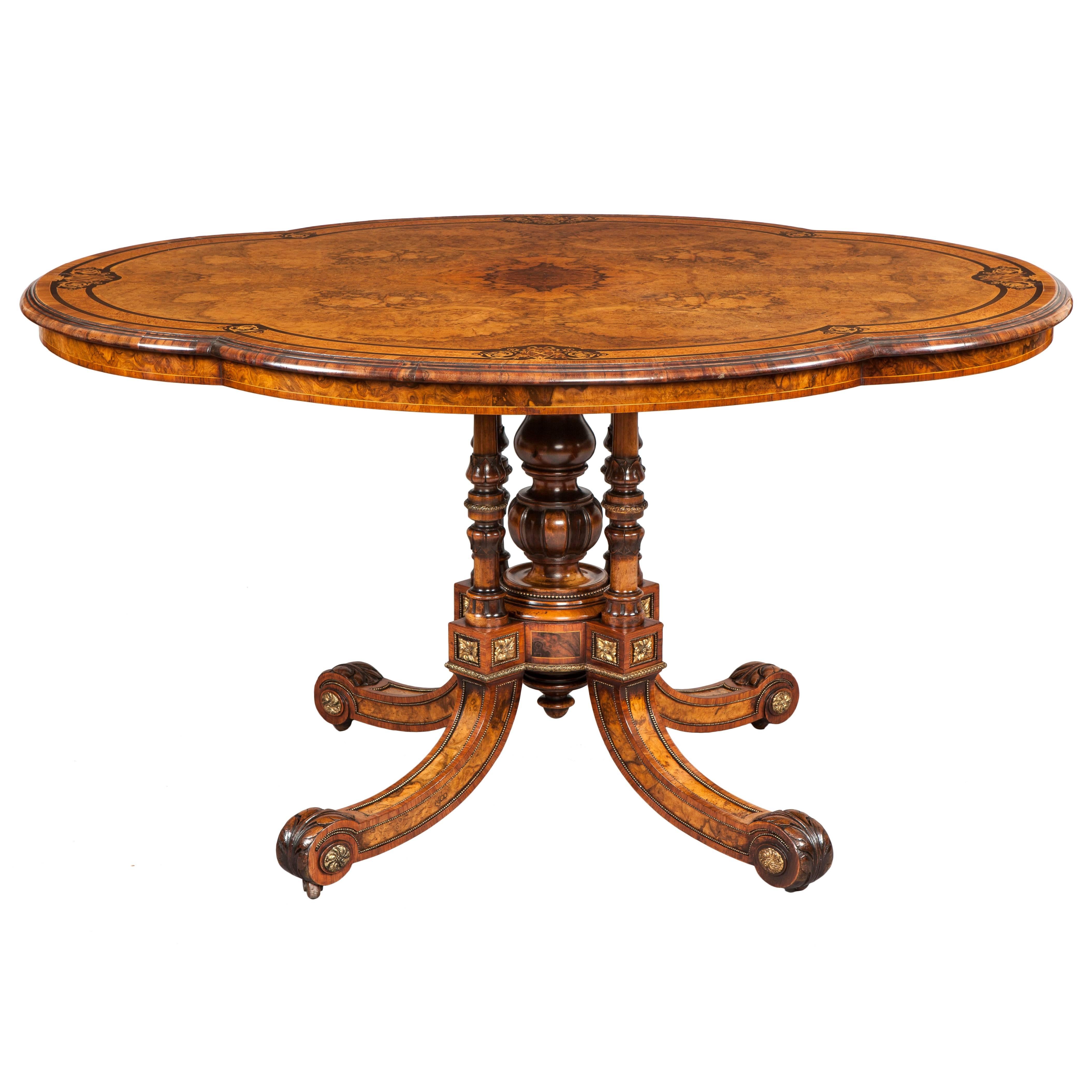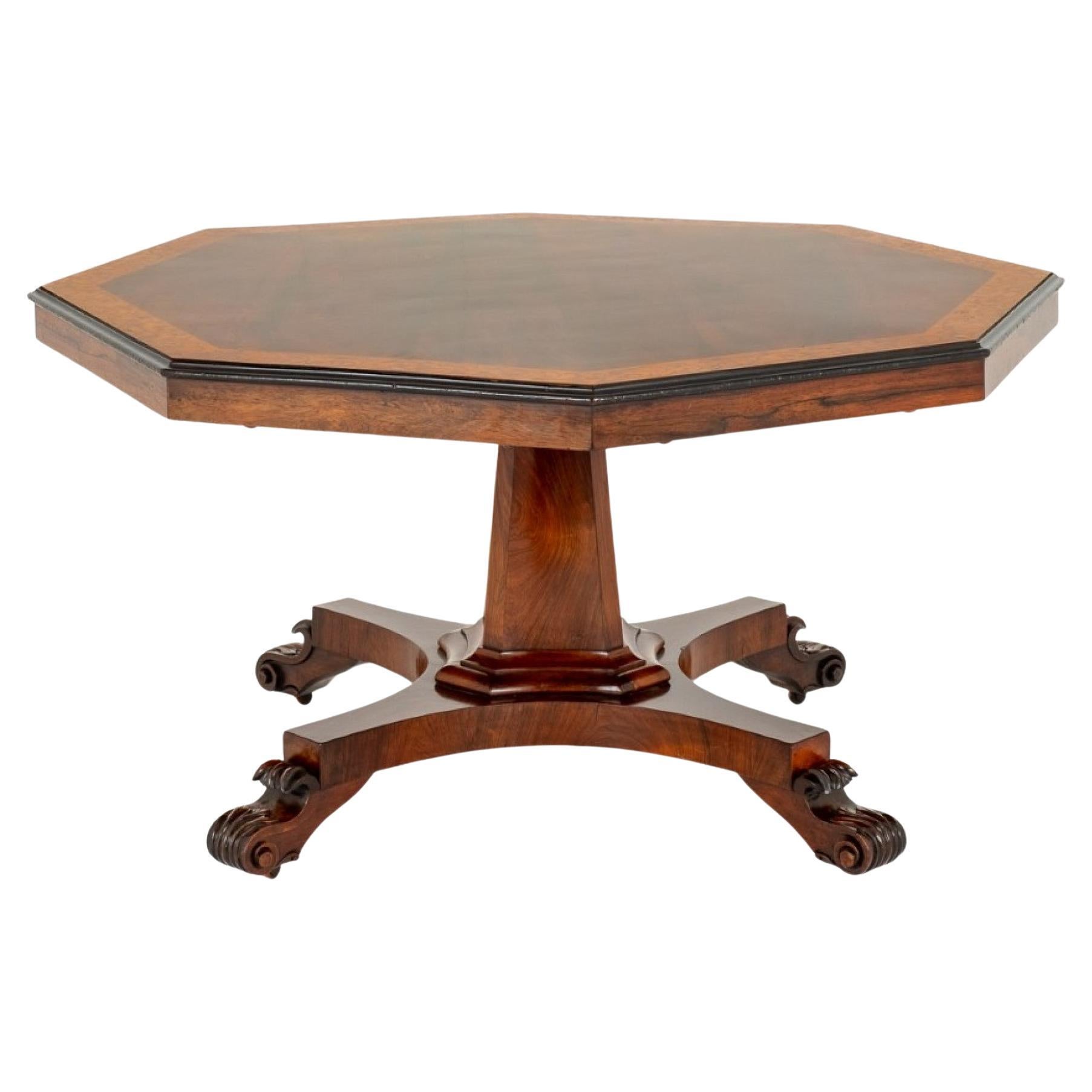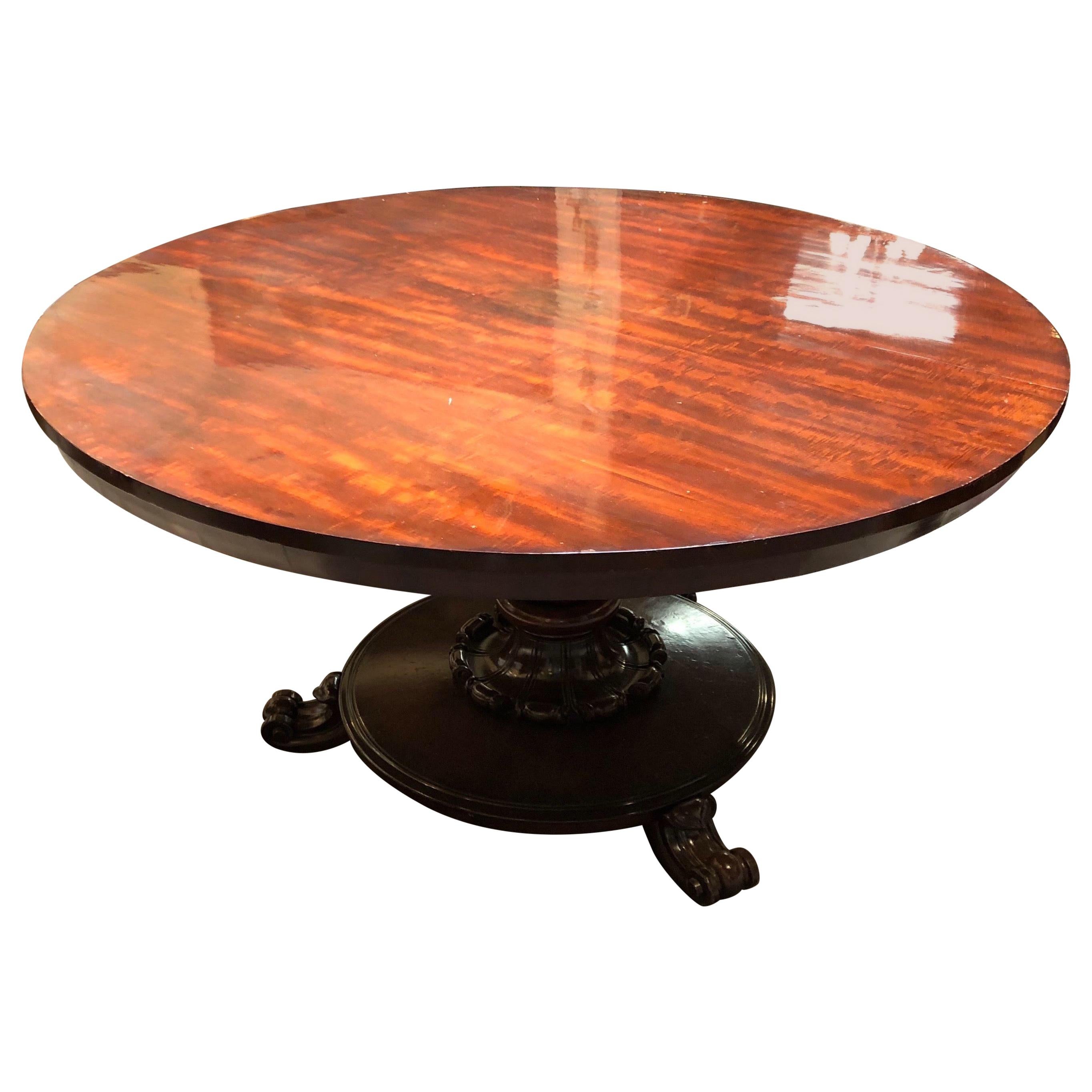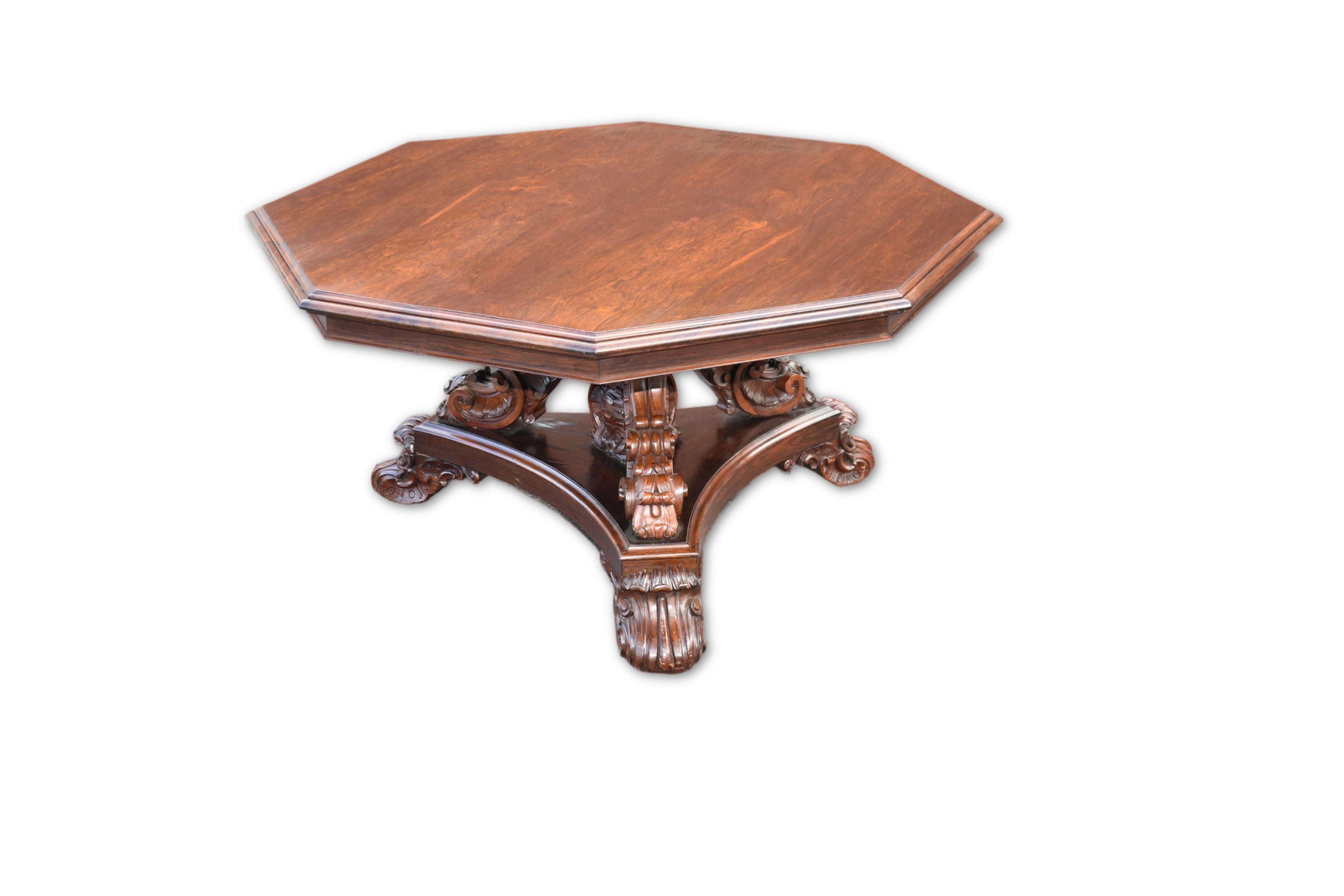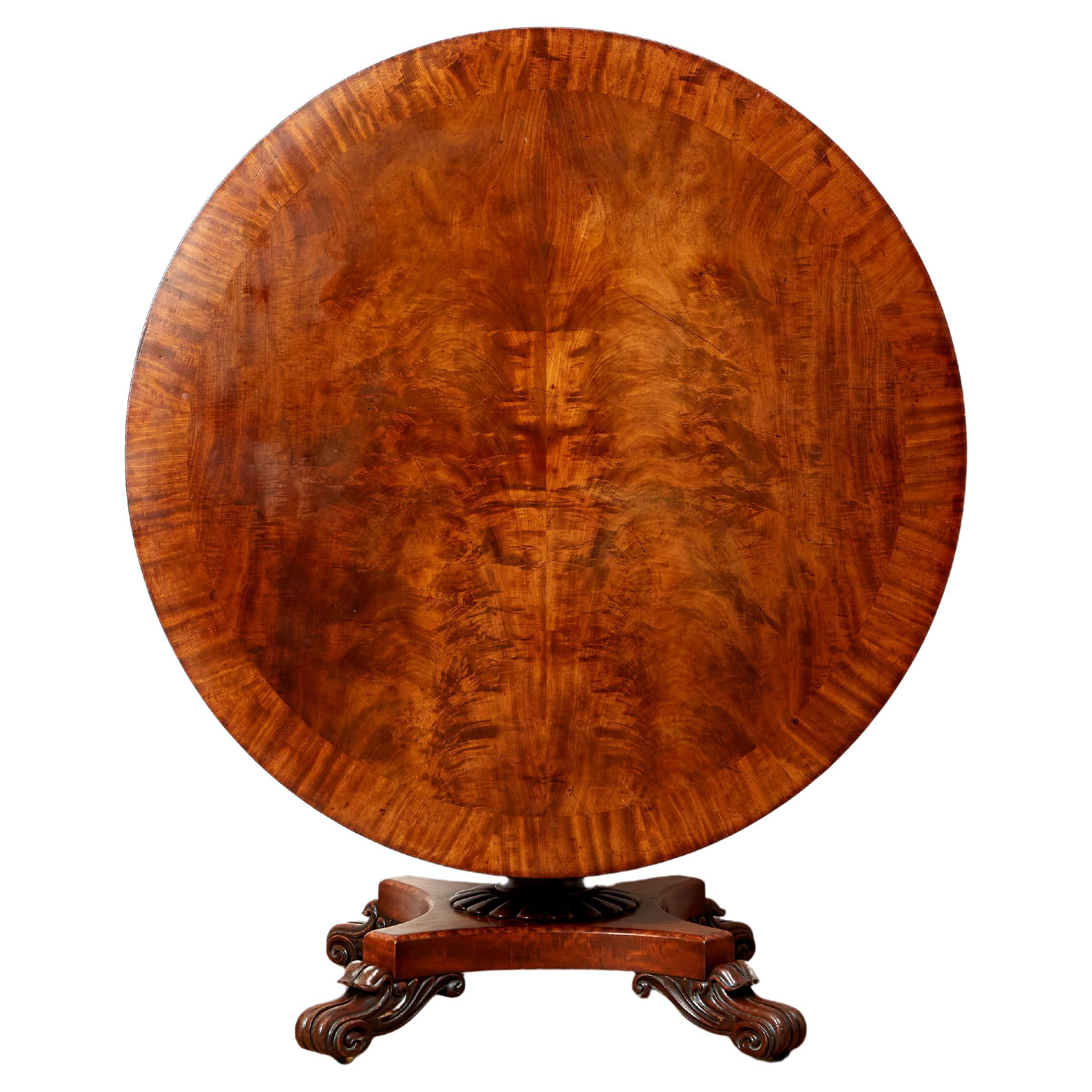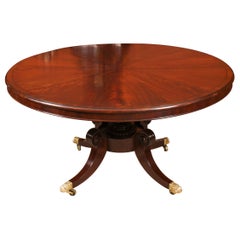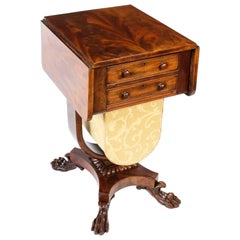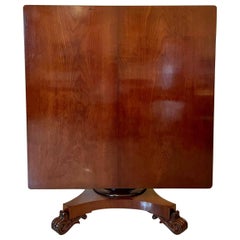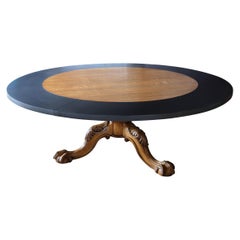
Antique William IV Centre Breakfast Table by Gillows 19th Century
View Similar Items
Antique William IV Centre Breakfast Table by Gillows 19th Century
About the Item
- Creator:Gillows of Lancaster & London (Maker)
- Dimensions:Height: 28.35 in (72 cm)Width: 50.79 in (129 cm)Depth: 50.79 in (129 cm)
- Style:William IV (Of the Period)
- Materials and Techniques:
- Place of Origin:
- Period:
- Date of Manufacture:circa 1830
- Condition:
- Seller Location:London, GB
- Reference Number:Seller: A28911stDibs: LU950631302482
Gillows of Lancaster & London
It would be difficult to find an antique furniture enthusiast or collector unfamiliar with the name Gillows of Lancaster and London. The British furniture company — which has earned references in the writings of Jane Austen and elsewhere in literature — is renowned for its exceptional quality craftsmanship, and attracted designers such as Thomas Chippendale, Thomas Sheraton and George Hepplewhite in its heyday.
The firm was founded circa 1730 by Robert Gillow (1704–72), who worked as a joiner, housebuilder and overseas merchant before making furniture for homes and export. Gillow established his business in his home city of Lancaster. However, the company later expanded into London in the 1750s after Robert entered into a partnership with his son, Richard, who apprenticed with a London architect and learned the merchant trade in Barbados. Richard had entrepreneurial aptitude — he managed apprenticeships at the firm, ensured that quality materials were a priority, navigated economic hardships, and designed furniture, too. He created seating based on sketches drawn by his cousin, James Gillow, in London.
London’s wealthy upper class took notice of the Gillows’ high-quality furniture, which came to include bedroom furniture, cabinets, a range of seating and other pieces made of rosewood or rich mahogany imported from the West Indies and Jamaica. By the end of the 18th century, the manufacturer was one of the leading furniture makers in Britain. Gillows designed its own furnishings and worked with significant designers; they had in-house upholsterers and cabinetmakers and employed decorative techniques such as “japanning” in their designs.
Gillows of Lancaster and London became Gillow & Co. in 1813 after selling to Redmayne, Whiteside and Ferguson. The company continued to thrive throughout the Georgian era and into the Victorian period, a time that yielded well-known collaborations with Scottish architect and designer Bruce Talbert on a regular basis. High-brow clients of the manufacturer clamored for their inventive and functional designs for tables and writing desks, many of which incorporated whimsical elements such as secret and pop-up drawers. There was also demand for earlier Gillow designs such as Baroque and Gothic Revival pieces as well as adaptations of Chippendale works.
Despite their success, Gillow & Co. entered into financial hardship during the late 1800s with the advent of mass-produced furniture. By 1903, they merged with Waring of Liverpool to become Waring and Gillows and, in 1980, were taken over by Maple & Co. to become Maple, Waring and Gillow. Today, many Gillows of Lancaster and London pieces are in museums throughout the United Kingdom, New Zealand and Australia.
Find antique Gillows of Lancaster and London furniture on 1stDibs.
- Antique William IV Loo Breakfast Dining Table c.1830 19th CLocated in London, GBA stunning antique William IV breakfast table / loo table, in the manner of Gillows, circa 1830 in date. The lovely figured flame mahogany circu...Category
Antique 1830s English Dining Room Tables
MaterialsMahogany
- Antique William IV Gilt Bronze Table Lamp, 19th CenturyLocated in London, GBA large, 72cm, beautiful English William IV table lamp, circa 1835 in date. The striking lamp features the original glass receiver, classic William IV design and has been converte...Category
Antique 1830s English William IV Table Lamps
MaterialsBronze
- Antique William IV Drop-Leaf Work Occasional Table Flame Mahogany, 19th CenturyLocated in London, GBAn exquisite antique William IV flame mahogany drop leaf work table, circa 1830 in date. The drop-leaf top with rounded corners supported by fly brackets ornamented with foliate scr...Category
Antique 1830s English William IV Tables
MaterialsMahogany
- Antique William IV Loo Dining Table & 6 chairs 19th CenturyLocated in London, GBA stunning antique William IV breakfast table / loo table in the manner of Gillows and the matching set of six William IV dining chairs, all circa...Category
Antique 1830s Dining Room Sets
MaterialsMahogany
- Antique Large William IV Silver Tray Salver by Paul Storr 1820 19th CenturyBy Paul StorrLocated in London, GBThis is a wonderful English antique William IV sterling silver tray, or salver, by the world famous silversmith Paul Storr. It has clear hallmarks for London 1820 the makers mark of Paul Storr. It is typical of his work with the octafoil shape and the exquisitely detailed reeded rim, and it is raised on four delightful foliate and scroll feet. The centre is engraved with a shield shaped coat of arms which I have had researched. The Marital Arms of Knollis and Hallifax The armorial bearings as engraved upon this George IV Large English Sterling Silver Footed Salver by Paul Storr hallmarked London 1820 are those of the family of Knollis with Hallifax in pretence. These armorial bearings denote the marshalling of a marital coat showing the arms of the husband over the entire surface of the shield, whilst the arms of the wife (as an heraldic heiress) are placed on a small shield (known as an escutcheon of pretence) centrally on the husband’s arms. They may be blazoned as follows: Arms: Quarterly 1st and 4th Azure crusily of cross crosslets a cross moline voided or (for Knollys) 2nd and 3rd Gules on a chevron argent three roses of the field barbed proper (for Knollys) over all an escutcheon of pretence Or on a pile engrailed sable between two fountains barry wavy of six argent and azure three cross crosslets of the first (for Hallifax) Crest: An elephant argent [differenced with a mullet1 ] (for Knollys) Motto: In utrumque paratus [Prepared for either] (for Knollys) These armorial bearings undoubtedly commemorate the marriage of The Honourable and Reverend Francis Knollis2 (baptised 3rd January 1743 died 27th February 1826), 1 The cadency mark for a third son of a family. 2 Francis appears to have preferred this spelling of his family’s surname. It is spelt as it is to be pronounced. of Burford in the County of Oxfordshire and of Eastleach Martin in the County of Gloucestershire and Mary Hallifax (baptised 5th March 1753 buried 18th December 1830). Francis and Mary were married at the Parish Church of St Mary, Ewell in the County of Surrey on the 9th June 1772. Francis was the third son of Charles Knollys (the titular 5th Earl of Banbury) 3 and his wife, Martha Hughes, whilst Mary was the daughter of The Reverend James Hallifax, of Ewell aforesaid and his wife, Elizabeth Chardavoyn. 3 Francis’s father claimed to be the 5th Earl of Banbury. A claim that continued to be pursued by the family until William Knollys, the titular 8th Earl of Banbury (born 1763 died 1834) was forced to discontinue its use by a resolution of the House of Lords which rejected his claim to the earldom in 1813. The crest surmounts a detailed dedication: This piece of plate was presented to the Honourable Rev Knolls by the inhabitants of the town and immediate neighbourhood of Burford on his completing the fiftieth year of his incumbency as the vicar of Burford. In testimony of their high respect 11th April 1821 There is no mistaking its unique quality and design, which is sure to make it a treasured piece by any discerning collector. Condition: In excellent condition with clear hallmarks and no dings, dents or signs of repair. Please see photos for confirmation. Dimensions in cm: Height 3 x Width 36 x Depth 36 Weight 1.52 kg Dimensions in inches: Height 1 inch x Width 1 foot, 2 inches x Depth 1 foot, 2 inches Weight 49 troy oz Paul Storr born in London England in 1771, was to become one of the most talented silversmiths of the nineteenth century. Today his legacy of exceptionally well crafted silver, found worldwide in museums and private collections, leaves one in awe when compared to that of his contemporaries.After having served a seven year apprenticeship from the age of 14, he began his career in 1792 when he went into a brief partnership with William Frisbee. This did not last and in 1793 a new mark, (his initials ‘P S’) was entered. By the beginning of the nineteenth century he had established himself as one of London’s top silversmiths producing, amongst others, commissions for Royalty. In 1801 he married Elizabeth Susanna Beyer with whom he was to have ten children. In 1807 Paul Storr entered into a working relationship with Philip Rundell and by 1811 was a partner, and managing the workshops for Rundell, Bridge & Rundell. During this period he kept his own marks and separate workshop. However it was through Rundell, Bridge & Rundell who were appointed Goldsmith in Ordinary to George III in 1804 that his reputation as a master silversmith grew. His talents lay in being able to transform ideas and designs from Rundell, Bridge & Rundell’s designers, William Theed...Category
Antique 1820s English William IV Sterling Silver
MaterialsSterling Silver
- Antique Large William IV Silver Tray Salver by Paul Storr 1837 19th CenturyBy Paul StorrLocated in London, GBThis is a wonderful English antique William IV sterling silver tray, or salver, by the world famous silversmith Paul Storr. It has clear hallmarks for London 1837 the makers mark of Paul Storr and is also engraved Storr & Mortimer 36, they were Goldsmiths and Jewellers to Her Majesty’ (1822-1839). It is typical of his work with the octafoil shape and the exquisitely detailed foliate and acorn rim. It is raised on four delightful foliate and scroll feet. The centre is engraved with a shield shaped coat of arms encompassing the lion rampant which I have had researched: The Arms of the Family of King The arms as engraved upon this William IV English Sterling Silver Footed Salver by Paul Storr hallmarked London 1837 are those of the family of King. They may be blazoned as follows: Arms: Sable a lion rampant between three crosses formy fitchy argent Undoubtedly this salver was in the possession of a gentleman who was member of a family bearing the name of King. There are a number of variants of these armorial bearings being borne by King families. Very often the lion is of a different tincture but the field of the shield is invariably remains ‘sable’. Similar arms and crest were recorded by Sir Edward Bysshe, Clarenceux King of Arms in his Visitation of the County of Kent of 1663 to the family of King, of Bromley. The tinctures of both arms and crest of King, of Bromley were slightly different to those engraved upon this tureen in that the Visitation family’s arms were ‘Sable a lion rampant ermine between three crosses paty fitchy or’ 1 and the crest ‘A lion’s gamb erect and erased sable holding a cross paty fitchy or’(see illustration below). These arms and crest were granted by Sir Edward Walker, Garter King of Arms on the 20th February 1660 – 61; and yet another Kentish family of King, of Bellevue who were created Baronets within the Baronetage of Great Britain in 1792 bore for their arms ‘Sable a lion rampant erminois between three crosses paty fitchy or’. Their crest being the same as the family of King, of Bromley. There is no mistaking its unique quality and design, which is sure to make it a treasured piece by any discerning collector. Please see potos of the 2nd Baronet Timothy Shelley, 1753-1844 and Castle Goring, his home. Condition: In excellent condition with clear hallmarks and no dings, dents or signs of repair. Please see photos for confirmation. Dimensions in cm: height 4 x width 44 x depth 44 Weight 1.96 kg Dimensions in inches: height 2 inches x width 1 foot, 5 inches x depth 1 foot, 5 inches Weight 63 troy oz Paul Storr born in London England in 1771, was to become one of the most talented silversmiths of the nineteenth century. Today his legacy of exceptionally well crafted silver, found worldwide in museums and private collections, leaves one in awe when compared to that of his contemporaries.After having served a seven year apprenticeship from the age of 14, he began his career in 1792 when he went into a brief partnership with William Frisbee. This did not last and in 1793 a new mark, (his initials ‘P S’) was entered. By the beginning of the nineteenth century he had established himself as one of London’s top silversmiths producing, amongst others, commissions for Royalty. In 1801 he married Elizabeth Susanna Beyer with whom he was to have ten children. In 1807 Paul Storr entered into a working relationship with Philip Rundell and by 1811 was a partner, and managing the workshops for Rundell, Bridge & Rundell. During this period he kept his own marks and separate workshop. However it was through Rundell, Bridge & Rundell who were appointed Goldsmith in Ordinary to George III in 1804 that his reputation as a master silversmith grew. His talents lay in being able to transform ideas and designs from Rundell, Bridge & Rundell’s designers, William Theed...Category
Antique 1830s English William IV Sterling Silver
MaterialsSterling Silver
- 19th Century William IV Maple Centre TableLocated in Gloucestershire, GBBeautiful 19th century Birdseye maple centre table. The whole is supported by two decorative pedestal bases and scroll feet. Beautiful colour and aged patina, in good condition!Category
Antique 19th Century English William IV Center Tables
MaterialsMaple
- 19th Century Large Quality Antique William IV Centre/Tilt Top TableLocated in Suffolk, GB19th century large quality antique William IV centre/tilt top table having an impressive quality mahogany top supported by a glorious hexagonal column and standing on a platform base...Category
Antique Early 19th Century English William IV Center Tables
MaterialsOther
- Gillows Early 19th Century Quarter-Sawn Oak Centre TableBy Gillows of Lancaster & LondonLocated in London, by appointment onlyA fabulous and powerful mid-19th century quarter-sawn oak centre table, now with custom made Corian extending leaves supported on the original slide-out bearers. The top supported on...Category
Antique Early 19th Century British Regency Dining Room Tables
MaterialsOak
- 19th Century Shaped Centre Table with Inlay and Gilt Metal by GillowsBy Gillows of Lancaster & LondonLocated in London, GBAn Antique Shaped Centre Table by Gillows Constructed in Circassian walnut, with specimen woods inlays, and gilt metal adornments; rising from a castor sho...Category
Antique 19th Century British Victorian Center Tables
MaterialsMetal
- Very Rare 19th Century William IV Period Centre Table in Goncalo AlvesLocated in Petworth,West Sussex, GBAn unusual 19th century centre table in Goncalo Alves, sort of rosewood with a circular tilt-top, turned baluster stem and a concave sided trefoil platform raised on scroll carved claw feet with concealed castors. England circa 1830. Superb quality. Gorgeous table with a lot of character, with good proportions, good height, exceptional width, good knee room and easy space to seat. Great colour and patina throughout. The dimensions are: Height: 72cm (28.3in) Diameter: 115cm (45.3in) This exceptional rosewood centre table is in good antique condition throughout. The antique centre...Category
Antique 19th Century British William IV Center Tables
MaterialsRosewood
- A Stunning Early 19th Century William IV Lamp or Side or Centre TableLocated in Dublin, IEA stunning early 19th Century William IV mahogany lamp, side or centre table, finely hand carved and of exceptional quality with rich patination and grain. The well figured moulded ...Category
Antique Early 19th Century English William IV Center Tables
MaterialsBrass

